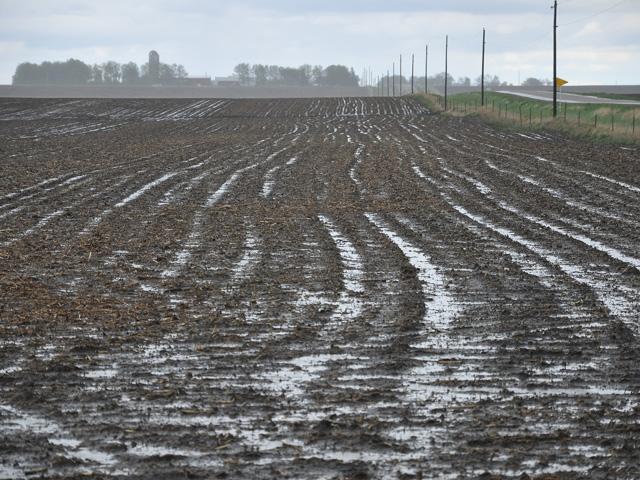Soil Diseases Welcome Cold Planting
Meet the Diseases Waiting for Your Seedling in Cold, Wet Soils
ROCKVILLE, Md. (DTN) -- Everyone hates the part of the movie where the defenseless young protagonist ventures down into a dark, damp basement, teeming with unknown horrors.
So, try not to do that to your own vulnerable young seedlings this spring, plant pathologists suggest. Many opportunistic soil-borne diseases are lurking in crop fields, and they do their best work when corn and soybeans are planted and forced to emerge slowly in the cool, wet conditions many farmers in the Corn and Soybean Belt are currently experiencing.
"If people are impatient, we will have issues," said Martin Chilvers, plant pathologist for Michigan State University. "Soybeans are good at compensating for some loss of stand, but especially for corn, uneven stand emergence is an issue, and you need to be careful about contributing to plant stress."
So, who will be the headliners of this particular season's movie, Revenge of the Mud? The most likely villains come in two types: oomycetes and true fungi, Chilvers explained.
Oomycetes are water molds, which produce swimming spores that use plentiful soil moisture to infect. Prepare to see a strong showing by two of these, Pythium and Phytophthora, in cool, wet soils, Chilvers said.
The likeliest fungal diseases to star in these conditions are Rhizoctonia root rot and Fusarium-led rots, including the fungus that causes Sudden Death Syndrome in soybeans, he added.
And with much of the western Farm Belt experiencing opposite conditions -- dry soils and wind -- growers there might also see a drought-loving root rot called Charcoal Rot, Chilvers added.
KNOW YOUR PROTECTION -- BUT DON'T OVERESTIMATE IT
The good news is that many commercially available seed treatments contain multiple active ingredients to tackle these diseases. The most common -- and oldest -- of these ingredients, metalaxyl and mefenoxam, target oomycetes like Pythium and Phytophthora. Newer products such as picarbutrazox (Vayantis), oxathiapiprolin (Lumisena) and ethaboxam (Intego Solo), are now also available to control this group of diseases, Chilvers noted.
Common fungicides such as triazoles and strobilurins are also often added to seed treatment packages to address fungal pathogens like Fusarium and Rhizoctonia.
P[L1] D[0x0] M[300x250] OOP[F] ADUNIT[] T[]
"However, while seed treatments absolutely can help with disease pressure, they're not silver bullets," Chilvers warned. That's especially true when seedlings sit in cold soils and struggle to emerge during the course of weeks. "Whenever seedlings are stressed or slow to emerge, they are more likely to be attacked by either group of pathogens," he said.
And if a seed suffers cold damage -- such as imbibitional chilling -- its injuries can lure the diseases in, like a shark smelling blood in the water, Chilvers explained.
"With imbibitional chilling, you start leaking solutes from the plant, and some pathogens can -- in a manner of speaking -- sniff those out and move toward the injured seedling and infect," he said.
PYTHIUM AND PHYTOPHTHORA
It can be hard to diagnose a rotted seedling after the fact, especially by these two diseases, which cause "a soft, watery rot," as Chilvers puts it.
Soft, brown roots and stunted, chlorotic leaves are often found when Pythium is at work, and Phytophthora can cause wilted plants, stunting and discoloration, with the root rot spreading to the stem, according to this guide from Michigan State: https://www.canr.msu.edu/….
See more on Pythium from the Crop Protection Network here: https://cropprotectionnetwork.org/… and more on Phytophthora here: https://cropprotectionnetwork.org/….
SUDDEN DEATH SYNDROME
The fungus that causes SDS in soybeans, Fusarium virguliforme, produces a two-step disease, noted Iowa State University plant pathologist Daren Mueller.
"Planting in cold, wet soils is the first hurdle," he explained. This allows the fungus to infect roots and set up camp. But for the disease to exhibit its telltale, sudden, late-season plant death, plentiful moisture is needed later in the season as well. "A big summer rain is the second hurdle," as Mueller puts it.
See more on SDS here: https://cropprotectionnetwork.org/….
FUSARIUM AND RHIZOCTONIA
Cold and wet aren't the only conditions these two fungal pathogens enjoy. Fusarium root rot can infect in slightly drier conditions, Mueller noted. And Rhizoctonia is happy with a little heat, as well, Chilvers said.
That's why the best defense against them, beyond seed treatments, are fast-emerging seedlings that don't linger in their tender seedling stage. "That's why I think of the emergence of plants as this race," Mueller said. "In general, when roots are growing slower, they're more vulnerable."
See more on these types of root rot from the Crop Protection Network here: https://cropprotectionnetwork.org/… and here: https://cropprotectionnetwork.org/….
CHARCOAL ROT
For growers facing drier conditions, Charcoal Rot is the greatest disease threat to emerging corn and soybean seedlings, especially if drought stress continues through the growing season. Caused by the fungus Macrophomina phaseolina, the disease becomes most visible later in the season, when black specks called microsclerotia dot the stems and roots of the infected plants.
See more here: https://soybeanresearchinfo.com/….
Emily Unglesbee can be reached at Emily.unglesbee@dtn.com
Follow her on Twitter @Emily_Unglesbee
(c) Copyright 2022 DTN, LLC. All rights reserved.






